What is a Geospatial File?
Geospatial files include GIS files, shapefiles, personal geodatabases, and geo-rectified images. tDAR accepts a range of geospatial files. Unlike documents, images, and other resource types, one complete geospatial object (e.g., shapefile, or GeoTIFF with associated world file, and project file) is associated with one resource within tDAR for both storage and billing. This helps tDAR capture appropriate metadata for each file.
Geo-rectified Images
tDAR accepts georectified TIFFs and JPGs. When providing a geo-rectified image, it is suggested that you store any point data in the header of the image. Optionally, You may upload any of the following additional files, with the same filename, but different extension along with your GeoTIF or GeoJPG:
Shape Files
tDAR accepts shapefiles from ArcGIS and other sources. All shape files must have at least these three parts:
- the main shape file “shp”
- the index file: “shx”
- the data file:”dbf”
Alternately, shapefiles may include additional, optional files:
- projection format file: “prj”
- index files: “sbn”, “sbx”
- read-only index files: “fbn”, “fbx”
- attribute index files: “ain”, “aih”
- attribute index of the DBF file: “atx”
- geocoding index file: “ixs”, “mxs”
- code-page file (charset) for DBF file: “cpg”
More information on shapefiles
Personal Geodatabases
tDAR does accept personal geodatabase (“mdb” and “gdb” files).
Pricing
Shapefiles, and geo-rectified images often require more than one actual file to work properly. Pricing for these files works as follows: each image, or Shapefile is treated as a single file within tDAR. Thus, if a user uploaded “untitled.shp”, “untitled.dbf”, “untitled.prj”, and “untitled.shp.xml” the combination of these four files would be treated as a single file for pricing.
Creating a Geospatial File
If you are just preparing to upload a new Geospatial File and would like to preview in a condensed format the information you will be asked to provide, check out our upload guide. This downloadable document summarizes the metadata required to upload a Geospatial File.
To create a new geospatial file, first login to tDAR. Click the “Upload” button on the tDAR toolbar. You can access this toolbar and button on any page within tDAR when you are logged in.

You will then be presented with a screen that asks you to select the resource type you wish to add. Choose “Geospatial File” from the options presented.

Basic Information
Basic information for a GIS resource includes the name of the associated project, the status of the metadata, the title of the data, the year the data were created, a narrative describing the currentness of the information used to create the file and any updates, the spatial reference system and project, the map source, and the scale.

Choosing a Status
In the “Status” field, select the status (either “active” or “draft”) that describes the state of this information resource. Select “active” to indicate that metadata entry is complete and that the resource is ready to be published once it is submitted. The status “active” means that the data set metadata is visible to all users through searching and browsing.
Select “draft” to indicate that metadata are NOT complete and that the resource is NOT ready to be published. Use the “draft” status to save your work (remember to click the submit button at the bottom of the data set entry page, though, to save your metadata in tDAR).
Note: Status does not inherit from a project to resources inside that project. Thus, a project may be marked as a “draft” or even “deleted” without affecting any of the resources within it.
Entering the Year
The “Year” field documents the year in which this data set was created and/or “published” in its current state. Use the textbox to enter the year your data set was created.
Currentness and Update Information
Use this section to describe how current the files being uploaded are, and whether any updates have been applied or will be applied in the future.
Spatial Reference System & Projection
Enter the spatial reference system and/or the projection used for the geospatial file (e.g., EPSG: 3857).
Map Source
Describe the source of the map and any basemaps used and include citations wherever possible.
Scale
Provide the scale for the map (e.g., 1:1600)
Choose an Account to Bill From
If you already have a billing account with tDAR, simply select the account you would like to bill to. If you do not have a billing account set up, see Creating and Managing Billing Accounts.

GIS Creators
In the “GIS” data entry section, list the persons who contributed to the construction of the dataset you are uploading to tDAR. A person who contributed to the creation of the GIS file may have served as an analyst, data entry technician, data collector/aggregator, dataset designer, etc.
Begin entering the name of a GIS file creator in one of the name fields in the “Person” data entry section. tDAR will make suggestions from a list of tDAR users and other entered persons (i.e., other creators, authors, editors, etc.). If one of the suggested persons matches the person you wish to identify as a creator, select that person. If the suggested persons do not include the person you want to identify, then enter that person’s name, email address, and institutional affiliation as accurately as possible. Enter a current email address and institutional affiliation ONLY if you are confident it is accurate.
To add additional creators, click on the “add another” button. Enter the appropriate information for that person and select the appropriate role.
In some cases, an individual person may not be credited with creation. Rather, an institution may be identified as creator of the GIS file. To add an institution as a GIS file creator, click on the “add another” button and select “Institution”.

Additional Citation Information
Additional citation information prompts you to add additional descriptors related to the publication of your GIS file. If the data are published, indicate the publisher and publisher location. You can provide a DOI (digital object identifier) if you have one, and a URL if the data or associated resources are published elsewhere on the internet.

Adding an Abstract/Description
This text field allows you to provide a narrative about the content of the GIS file. You will likely want to describe the research that guided the construction of the GIS file, some of the primary variables and variable states, the use and/or potential uses of the data set, and any important information that users may need to know to apply your data. Use the textbox provided to enter an abstract.

Attach GIS Files
After entering the general information, you should then select the file(s) you wish to upload to tDAR. Click on the “i” icon to see a list of accepted file types.

Click on the “Select Files” button and browse to the file you wish to upload. Once you upload the file, options for restrictions, date created, and description will appear.

Restricting Access to Files: Marking a File as Confidential and Marking a File as Embargoed
tDAR provides two different ways to restrict access to files you upload to tdar:
- mark the file as containing confidential information
- mark the file as an embargoed resource
Marking a File as Confidential
When you mark a file as containing confidential information, the file itself will never be accessible to the public. The file’s metadata remain visible, but the file itself is not visible and cannot be downloaded (unless you give access rights to a specific tDAR user).
To mark a file as confidential, select “Confidential” from the drop-down menu with the sub-heading “This item has access restrictions”.
Why would I mark a resource as “Confidential”? You may choose to mark a resource as confidential if you feel that it contains sensitive data that could endanger an archaeological resource, information that affiliated communities or other interested communities might not wish to be widely available, or information that you are not prepared to share. For example, you may choose to mark a GIS file that contains mortuary feature data as confidential to respect the wishes of affiliated communities to restrict access to this information. These data should likely remain restricted to professional bioarchaeologists and others who will treat the information with proper respect.
Marking a File as an Embargoed Resource
When you mark a file as embargoed, you are restricting access to the file for 5 years. In other words, the file will not be accessible to the public for the next 5 years. The file’s metadata will be visible during that period, but the file itself is not visible and cannot be downloaded. After the embargo period has ended, the file will become accessible to the public.
To mark a file as embargoed, select “Embargoed from the drop-down menu with the sub-heading “This item has access restrictions”.
Why would I mark a resource as “Embargoed”? You may choose to mark a file as embargoed to restrict access to the resource for a limited period of time. For example, you may wish to register a GIS file with tDAR that houses data for an ongoing research project. You would like to store the data and share it with a select group of colleagues working with you on the research project. However, these data must remain restricted until the project is complete and results are published in some fashion. You can mark this resource as embargoed to indicate that it is restricted for a period before it can be made available to the public.
How do I allow certain users to view my confidential / embargoed resource?
To permit other registered tDAR users to download confidential/embargoed files, you must enter their names into the “Access Rights” fields at the bottom of the data set entry page. You can grant ONLY registered tDAR users the access rights to download these files.
Uploading Additional Files
If you wish to upload more than one file, click on the “add another file” button that appears after your first file has been uploaded. Then, click on the new “Browse” button and browse to the other file you wish to upload.
tDAR Collection and Project
You can add your GIS file to an existing Collection or Project that you have permission to edit. To select a Collection, start typing the name of the Collection in the text box and select the name when it appears in the drop-down box. You may also use this text box to name a new, public Collection that will be created when you save your dataset and will only contain the new GIS file. To choose a Project, use the drop-down menu to select from Projects that you have permission to edit. Check the box below the project text box to enable inheritance of metadata from that Project.

Institution Authorizing Upload of this GIS
The “Institution Authorizing Upload of this GIS” section records the institution that “owns” the resource (i.e., sponsored the production or publication of the document) and/or that gave you permission to upload the resource to tDAR. For example, if the Bureau of Land Management (BLM) sponsored a report and they provided you permission to upload that report to tDAR, the BLM should be entered in the “Institution Authorizing Upload of this GIS” section.

Individual and Institutional Roles
You can use these fields to credit the individuals and institutions that contributed to the resource. You can toggle between person and institution using the buttons on the left side of the text boxes. Select the role that best describes their contribution. Use the “add another” button to add additional contributors.

Adding GIS Specific or Agency Identifiers
GIS Specific or Agency Identifiers in tDAR can include a wide range of values:
- contract numbers
- internal project numbers
- permit numbers
- etc.
If you have added the dataset to an existing project, you can choose to inherit the data in this section.

To enter an identifier
- click in the “Name” field
- begin typing the identifier name. For example: “State of California Contract Number”, “BLM Permit Number”
Spatial Terms
Spatial terms describe the location of your GIS file. The spatial information entry section includes two separate components:
- geographic terms for general location keywords, including named regions, geographic features, states, towns, etc.
- a map that allows you to draw a box around your project area
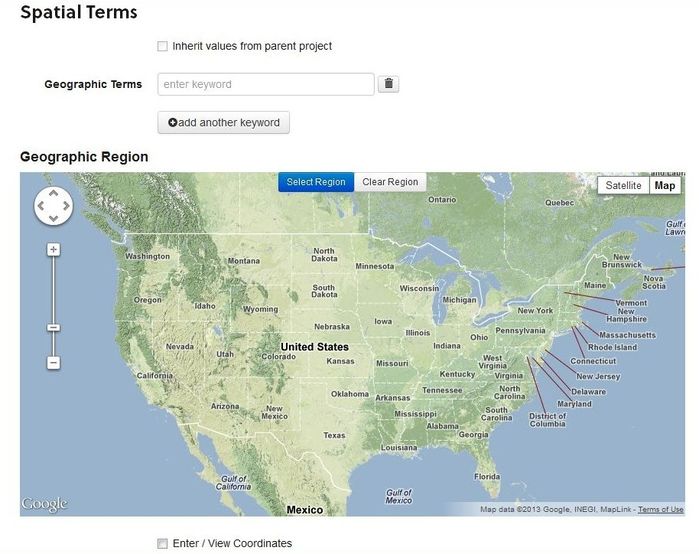
Note: If you draw a location box that is 1 square mile or less in area, tDAR will display a wider box to other users to protect your project area/site location. See the section “What if I want to hide my site location?” below.
Drawing a bounding box around your site
- use the Google Map display to navigate to your site location
- click the “Select Region” button
- draw a box that best approximates the area that your project investigated
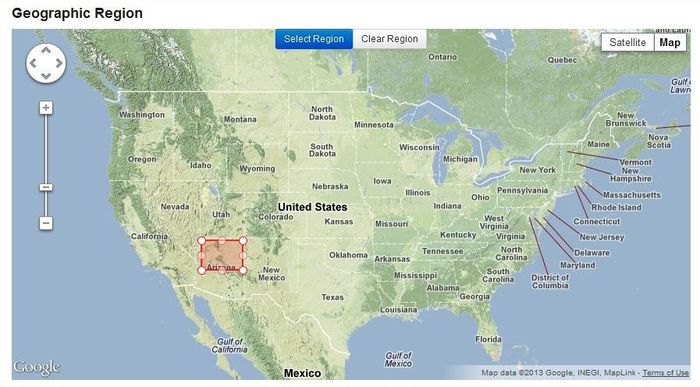
Entering Coordinates Manually
If you know the exact coordinates of your project area, you can enter them manually into tDAR. Click on the checkbox next to “Enter / View Coordinates.” Coordinates can be entered in several different formats. For example:
- 40°44′55″N
- 53 08 50N
- Decimal: -73.9864

What if I want to hide my site location?
tDAR provides several options to protect the exact location of your project area and/or sites. If your bounding box is less than 1 mile square, tDAR will alter that box when it is displayed to users to obfuscate or hide the exact location. Alternately, you may simply draw a wider box.
What if I entered my site location incorrectly?
Simply click the reset button. You may also click on the “Enter / View Coordinates” and adjust the spatial information manually.
Temporal Coverage
Temporal coverage includes temporal keyword terms, calendar date ranges, and radiocarbon date ranges (if available) for the archaeological/cultural resources that your project investigated.
Enter as many or as few temporal terms as you would like to describe the temporal coverage of your GIS file. Use the “add another temporal keyword” box to add additional terms. Use the ” – ” box to delete a temporal term that you entered in error or that you would like to remove from your project description.
Coverage Dates
Use the drop-down box to select either Calendar Date or Radiocarbon Date. Enter a calendar start date and a calendar end date for the sites or other archaeological/cultural resources that your project investigated. Use only numeric values in the calendar date text boxes (Do not enter calendar era designations such as “B.C.E” or “A.D.”). To denote a date in the “B.C.E.” designation, simply place a ” – ” before the date’s numeric value. Thus, ” – 200 ” is equivalent to ” 200 B. C. E.”
If available, enter a radiocarbon date by selecting “radiocarbon date” from the drop down menu, and enter a start date and an end date for your project’s archaeological resources.

Investigation Types
Investigation types describe the various types of activities performed in the project related to your GIS file. Select as many or as few types that apply to your file.
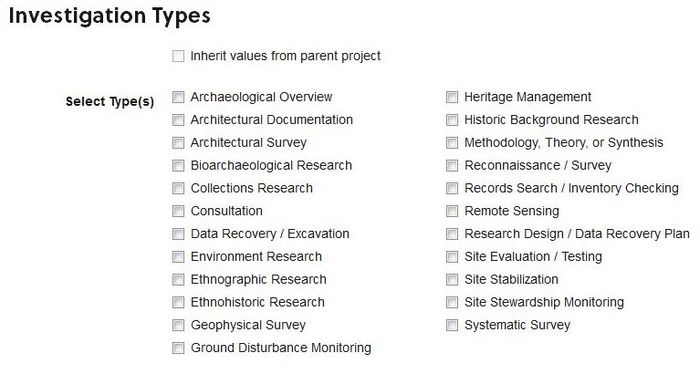
Note: You can hold your cursor over any investigation type to obtain a detailed description of the activities included in that investigation type.
Material Types
The material types section describes the types of materials that were collected, analyzed, or discussed as part of your project. Select as many or as few that apply to your project.
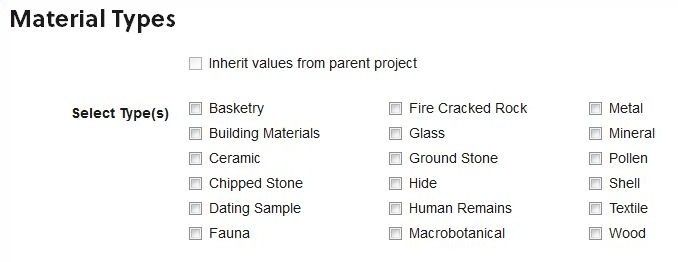
What if my material type is not listed?
If a material type you’re expecting is not listed above, you have two options:
- enter the material type in the “General Keywords” section
- contact tDAR and ask for it to be added
Cultural Terms
Cultural terms describe the archaeological cultures and/or historic population groups who are affiliated with the cultural resources in your project. Select as many or as few cultural terms as you would like to describe the groups of people affiliated with your project’s research.
Within tDAR, cultural terms can be specific or general. tDAR will mark specific cultural terms with their generalized equivalents (e.g., “Early Woodland” is also marked as “Woodland”). Thus, if you select the specific cultural term “Early Woodland”, your record will also be found by a user who searches for the more general term “Woodland”.
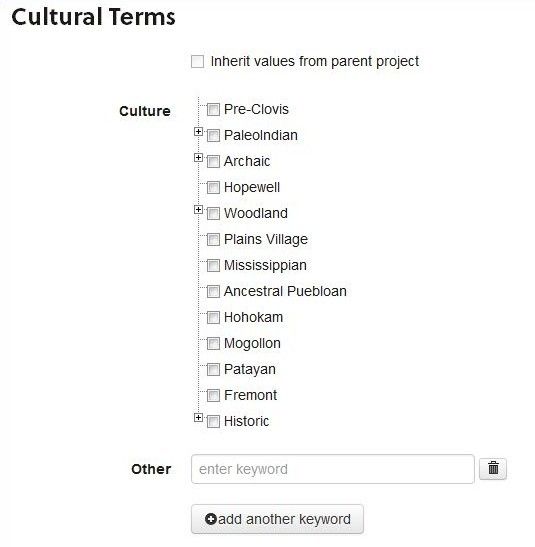
Note: Click on the ” + ” box next to a cultural term to open a list of more specific cultural terms.
What if the cultural term I want to use is not listed?
If a cultural term you would like to use is not listed, please add it to the “Other” section at the bottom of the cultural terms section. Data curators review these terms regularly and update the list of cultural terms to reflect commonly entered values.
Site Information
The site information section includes the names of the sites investigated during your project and a summary of the types of archaeological resources found at those sites.
Enter as many or as few site names as you would like to describe the work completed. Use the “add another keyword” to add more sites. Use the trashcan icon to delete site names that you entered in error or that you no longer would like to associate with the project.
Select the “Site Type” descriptors that best describe the archaeological/cultural resources that occur at the sites you listed in the “Site Name” text boxes.
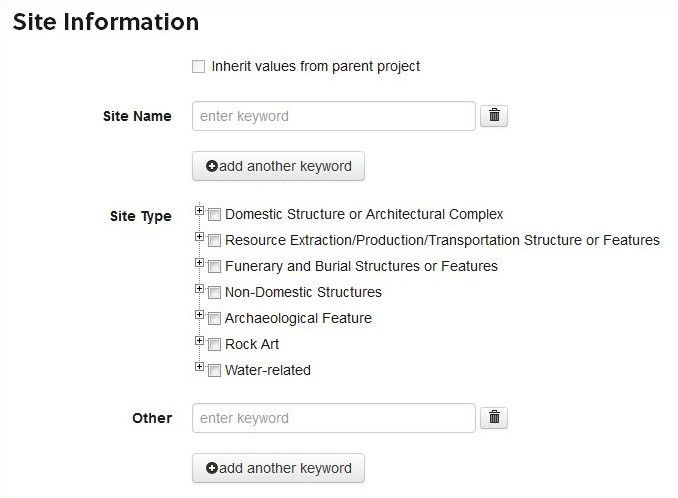
Note: Click on the ” + ” box next to a site type to open a more detailed list of descriptions for that site type. Select all the type descriptions that apply to the sites you listed above in the “Site Name” text boxes.
General Keywords
General keywords allow you to add any additional terms that are not included in the other project metadata. This may include specific types of investigations undertaken as part of your project (e.g., “material sourcing”, “ceramic petrography”, “experimental archaeology”), specific site types (“rock gardens”, “ground stone production area”, “shrine”), etc.
Enter these keywords into the text provided. If you decide to enter additional keywords, enter succinct keyword terms that accurately describe your project. Also, enter succinct terms that researchers in your area use commonly.

Notes
The notes field allows you to enter any additional information about your GIS file that is not captured in the project metadata fields. This field acts as a comments section, where you can enter a small narrative that might help other users better understand some important aspect of your project.
Select the type of note you wish to create from the “Type” drop-down box. Enter your note in the text field provided.
